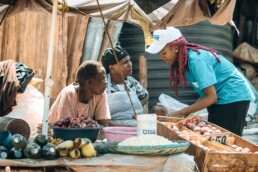What Impact Means to SHOFCO
We believe impact goes beyond numbers. While we track quantitative metrics like school attendance and access to clean water, these figures alone fail to capture the transformative changes in people’s lives. Qualitative impact is equally vital; it reveals how our programs empower individuals, strengthen communities, and drive long-term systemic change. Traditional measures of success, such as the number of children in school, don’t reflect what they are learning or the support they receive. The true markers of impact extend beyond data, focusing on the meaningful differences we make in lives and communities.
Monitoring, Evaluation and Learning
Our Monitoring, Evaluation, and Learning (MEL) approach is designed to drive meaningful and lasting change in the communities we serve. We implement a holistic impact measurement framework that assesses our initiatives across three interconnected layers: individual, community, and systems change.
SHOFCO is dedicated to the robust monitoring and evaluation of our programs and the inclusion of the community in this process.
The community identifies the focus of SHOFCO’s services through annual random surveys assisted by GPS technology. Since 2010, SHOFCO has annually recorded responses from over 1,000 households in Kibera regarding program utilization and a wide range of indicators including attitudes on gender and family roles, healthcare access, economic indicators, and educational attainment. The research serves two primary purposes: to establish a representative community “baseline” or random control group against which to measure our program outcomes and to function as a community needs assessment, helping to inform program development. We conduct similar annual surveys of SHOFCO members.
Additionally, SHOFCO provides every beneficiary with a unique ID card, allowing us to document every program use through barcode scanning. Each program has an annual work plan developed by our local program managers that provides a roadmap for achieving the established program outcomes and annual beneficiary goals.
Through our metrics and evaluation, we have seen a decrease in water-borne illnesses and typhoid over time in the areas with clean water distribution kiosks and health clinics. We have also seen an increase in the employment status of our members, likely due to their access to SHOFCO’s economic empowerment service and wide network.
In addition to the annual survey, data collected through our individual services greatly inform our program impact and efforts. For example, we have seen a drastic increase in the number of reported cases of sexual and gender-based violence over the years. Our gender development department and community health workers’ efforts have decreased the stigma in the community against sexual and gender-based violence reporting as well as increased the number and variety of access points where victims can report cases and receive services. These are only a few examples of some of the systemic shifts that our services have catalyzed, allowing our community members to lift themselves out of poverty to lives of promise.
How We Measure Impact
Each year, SHOFCO conducts GPS-assisted random surveys to understand community priorities and measure impact. Since 2010, we’ve gathered insights from over 1,000 households in Kibera on gender, health, education, and economic wellbeing. The data serves as both a baseline to track progress and a needs assessment to guide our programs. Additionally, every SHOFCO beneficiary receives a unique ID card, enabling us to document every program use through barcode scanning. We also survey SHOFCO members annually. Our measurement approach is rooted in a holistic understanding of impact.

Measurement framework
We implement a holistic impact measurement framework that assesses our initiatives across four core pillars: individual, community, informal settlements and the nation.
Scroll to read
| Priority | Individual | Communities | Informal Settlements | Nations |
|---|---|---|---|---|
| Driving collective change | Equipped with knowledge of their rights and community-building skills, individuals can confidently advocate for change, promoting collective resilience. | Organized communities actively engage in local decision-making, driving sustainable change to benefit all members. | Informal settlements become vibrant hubs where the voices of residents influence policies that address local needs. | Collective community action shapes inclusive national policies, contributing to a society that values and amplifies all voices. |
| Inclusive and equitable | Each person experiences dignity and equal opportunity, contributing to financial stability and personal growth. | Diverse communities foster solidarity and celebrate all voices, working collectively to overcome social barriers. | Inclusive policies and initiatives break down barriers, making informal settlements integral parts of the urban economy. | National progress is marked by equitable practices that empower marginalized communities to participate fully in society. |
| Strong and supported | Access to quality health and education fosters physical, mental, and social well-being, enabling people to live fulfilling lives. | Strong health and education systems build a supportive foundation for resilient, productive communities. | Investments in health and education transform informal settlements into thriving spaces where everyone can access essential services. | Widespread health and education initiatives reduce inequality and improve overall national well-being. |
| Mobilized for opportunity | With skills, resources, and economic agency, individuals can pursue growth opportunities and contribute to their local economy. | Communities foster an environment of opportunity, supporting personal growth and shared economic development. | Pathways for economic advancement transform slums into economic contributors, bridging the gap with formal economies. | A skilled, economically active population drives national development, with individuals and communities supporting sustainable growth. |
| Informed and engaged | Individuals are well-informed and critically engaged, contributing actively to their community and holding others accountable. | Knowledge-sharing within communities strengthens civic participation and trust in collective action. | Access to information empowers slum residents to participate in urban governance, shaping a more accountable and inclusive city. | Informed citizens drive democratic engagement, influencing national policies through collective, informed decision-making. |
To measure these impacts, we employ six key markers: Practices, Policies, Resource Flows, Relationships and Connections, Power Dynamics, and Mental Models.
Six Conditions of Systems Change

Localization
Localization is central to SHOFCO’s mission and how we measure impact. We believe that the people who live in the communities we serve are best equipped to drive their own development. They understand their challenges and strengths better than anyone else, and we work to ensure that our programs and metrics reflect this local knowledge.
By co-designing our monitoring and evaluation systems with local communities, we ensure that our success metrics are both meaningful and effective. This localized approach also helps us push back against the idea that growth or replication are the only ways to measure success. For us, success is not just about reaching more people—it’s about making sure that our interventions are deeply transformative and aligned with local priorities.
